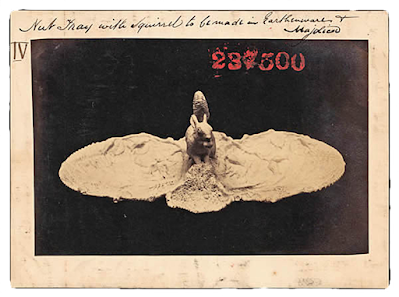As some of you may know, Wedgwood named their majolica patterns. We know this from the entries in the Wedgwood pattern books. A study of these entries, one would assume, is a good indication of the popularity of individual patterns. Patterns with many entries are likely to be more popular than patterns with less entries. Some of these different pattern numbers may only be different colorways so we aren't necessarily talking about different designs. Still, for a collector this information can be instructional.
Maureen Batkin did a study of these patterns in her book Majolica: British, Continental and American Wares 1851-1915 and found that the patterns with the most entries were as follows:
Maureen Batkin did a study of these patterns in her book Majolica: British, Continental and American Wares 1851-1915 and found that the patterns with the most entries were as follows:
- Fan (90 entries)
- St. Louis (79 entries)
- Grosvenor (79 entries)
- Italian (72 entries)
- Luther (70 entries)
Wedgwood majolica Fan cheese bell
Wedgwood’s majolica St. Louis pattern
In auctions and shops, Grosvenor, St. Louis and Luther are generally identified as just being generic aesthetic patterns. Grosvenor and Luther are very similar to the casual eye and could be easily confused but there are differences and I thought we could look at those here.
First, let's look at Grosvenor.
Wedgwood majolica Grosvenor platter
It was the only Wedgwood pattern designed for dinner use, a break from the specialized use of the other Wedgwood tablewares. Considering this to be the case, we have never seen a complete set of dinnerware in this pattern. Still, it is an easy pattern to find and like the other Wedgwood aesthetic patterns does not
command high prices.
Wedgwood majolica Grosvenor oyster plate
Wedgwood majolica Grosvenor platter
Wedgwood Grosvenor cheese bell
Wedgwood majolica Grosvenor syrup
Wedgwood majolica Grosvenor teapot
Wedgwood majolica Grosvenor sardine box
Wedgwood majolica Grosvenor jardiniere
Wedgwood majolica Grosvenor jardiniere
The second pattern is Luther.
Wedgwood majolica Luther platter
The most distinctive feature of Luther is the lattice design that fills the large spaces in between the narrow ribbed borders that divide the design. Instead of pots full of fruit bearing pomegranates there are flowering tree blossoms. Alternating panels have a thick frame that surrounds the lattice design. Like Grosvenor, Luther is also rather easy to find and generally inexpensive.
Wedgwood majolica Luther cheese bell
Wedgwood majolica Luther cheese bell lid with a Primrose base
Wedgwood majolica Luther cheese bell
Wedgwood majolica Luther cheese bell
Wedgwood majolica Luther cheese bell
Wedgwood majolica Luther jug
Wedgwood majolica Luther syrup
Wedgwood majolica Luther syrup
Wedgwood majolica Luther cheese bell
Wedgwood majolica Luther salad set
Wedgwood majolica Luther sardine
Italian however is not.
As you would expect from a pattern named Italian, this design uses classical motifs to populate the design. Like the other designs, Italian is divided into sections but in this case, the panels are utilized in an entirely classic manner. There is no severe abstraction as in Grosvenor and Luther, just an elegant, somewhat over-the-top collection of classical urns, garlands and acanthus leaves. Pomegranates also appear on this design as do flowering branches of different types.
Wedgwood majolica Italian jardiniere and pedestal
Wedgwood majolica Italian jardiniere and pedestal
Wedgwood majolica Italian jardiniere and pedestal
I want to add here that although these five patterns may have been popular enough at the time for Wedgwood to create numerous versions of them, they are not at all those most popular among today's collector. In fact the truth is quite the opposite. With the possible exception of Fan, aesthetic inspired Wedgwood designs are probably the least popular designs among modern collectors. That is what accounts for their relatively inexpensive prices. More traditionally representative Wedgwood patterns like Ocean are much more popular. Where other aesthetic patterns such as Chrysanthemum and Stanley have strong Japanese influence they are generally not considered Aesthetic Movement patterns by the layman and are highly coveted by collectors.



































































